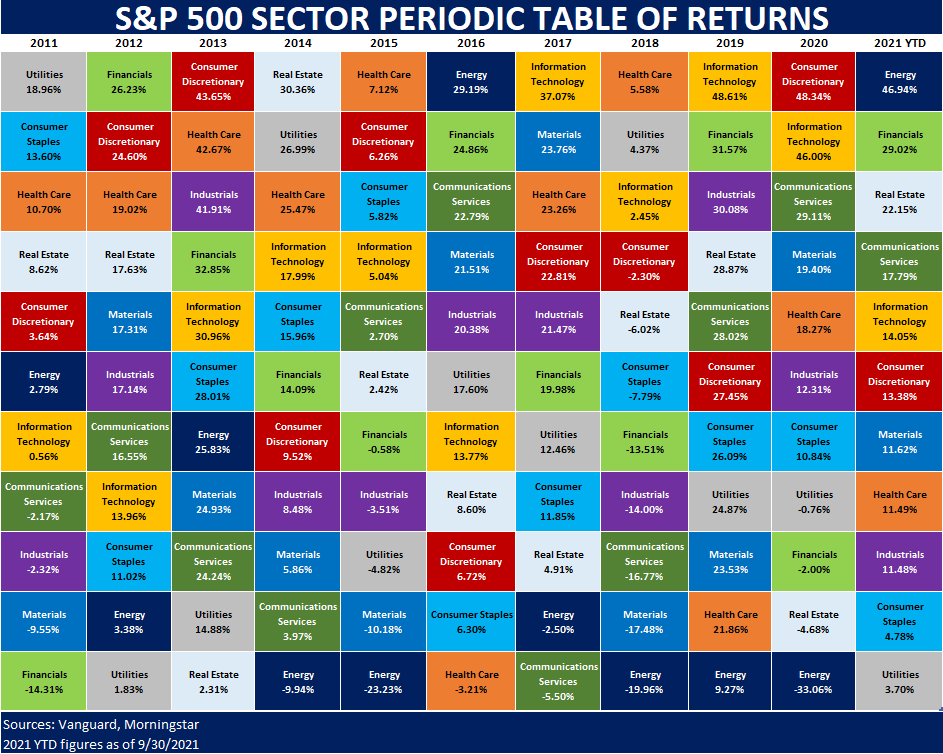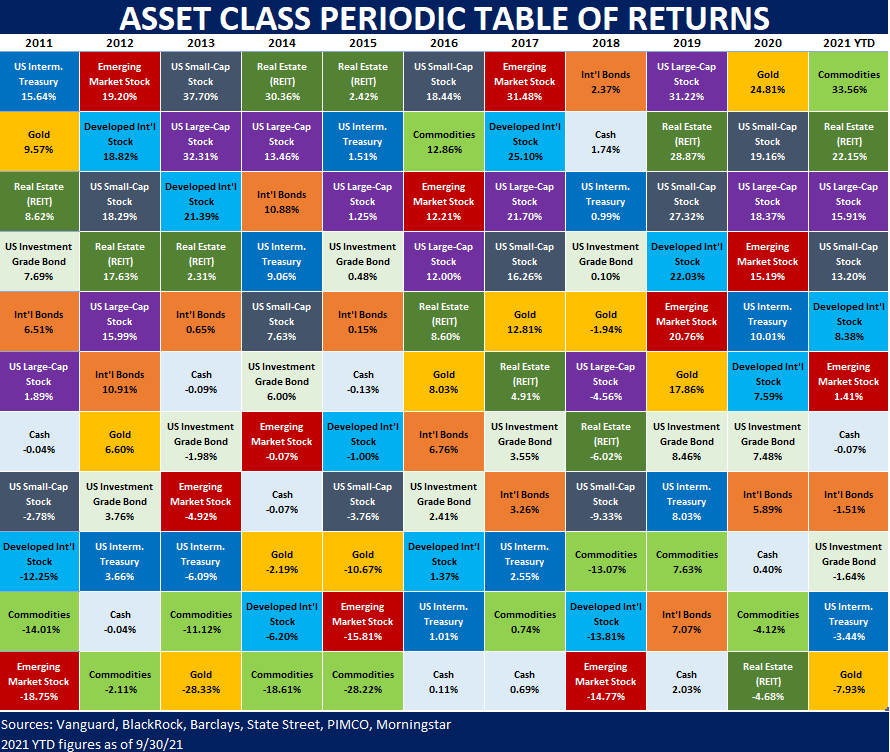third Quarter 2021 Market Returns:
S&P 500 Sectors & Asset Classes
The below charts visually demonstrate that the drivers of return are constantly changing each year, which emphasizes the importance of a well-diversified portfolio. In this article we provide a snapshot of recent S&P 500 sector and asset class performance.
S&P 500 SECTOR PERIODIC TABLE OF RETURNS (2011 - 2021)
This chart contains the 11 sectors which constitute the S&P 500 Index. Each sector is given a unique color, and each column is organized from highest return (top) to lowest return (bottom), for a given year. The first 10 columns display annual performance for each sector from 2011 to 2020. The last column on the right, illustrates year-to-date (YTD) performance, as of 9/30, for 2021.
2021 YTD Leaders:
- Energy = 46.94%
- Financials = 29.02%
- Real Estate = 22.15%
2021 YTD Laggards:
- Utilities = 3.70%
- Consumer Staples = 4.78%
- Industrials= 11.48%
ASSET CLASS PERIODIC TABLE OF RETURNS (2011 - 2021)
This chart is composed of 11 standard asset classes. Each asset class is given a unique color, and each column is organized from highest return (top) to lowest return (bottom), for a given year. The first 10 columns display annual performance for each asset class from 2011 to 2020. The last column on the right, illustrates year-to-date (YTD) performance, as of 9/30, for 2021.
2021 YTD Leaders:
- Commodities = 33.56%
- Real Estate (REIT) = 22.15%
- US Large-Cap Stock = 15.91%
2021 YTD Laggards:
- Gold = -7.93%
- US Interm. Treasuries = -3.44%
- US Investment Grade Bond = -1.64%
Please feel free to reach out to us with any questions.
Definitions
YTD = Year to date
Interm. = Intermediate Term
S&P (Standard & Poor’s) 500 - is a stock market index that measures the stock performance of 500 large companies listed on stock
exchanges in the United States.
Sources
Vanguard, Morningstar, BlackRock, Barclays, State Street, PIMCO
Important Disclosure Information
The Mather Group, LLC (TMG) is registered under the Investment Advisers Act of 1940 as a Registered Investment Adviser with the Securities and Exchange Commission (SEC). Registration as an investment adviser does not imply a certain level of skill or training. The opinions expressed, and material provided are for general information and should not be considered a solicitation for the purchase or sale of any security. The opinions and advice expressed in this communication are based on TMG’s research and professional experience and are expressed as of the publishing date of this communication. All return figures shown are for illustrative purposes only. TMG makes no warranty or representation, express or implied, nor does TMG accept any liability, with respect to the information and data set forth herein. TMG specifically disclaims any duty to update any of the information and data contained in this communication. The information and data in this communication does not constitute legal, tax, accounting, investment, or other professional advice nor is it intended to provide comprehensive tax advice or financial planning with respect to every aspect of a client's financial situation. Investing in securities involves risks, and there is always the potential of losing money when you invest in securities. Before investing, consider your investment objectives. Past performance does not guarantee future results.
An index is a portfolio of specific securities, the performance of which is often used as a benchmark in judging the relative performance of certain asset classes. Indexes are unmanaged portfolios and investors cannot invest directly in an index. An index does not charge management fees or brokerage expenses, and no such fees or expenses were deducted from the performance shown.









